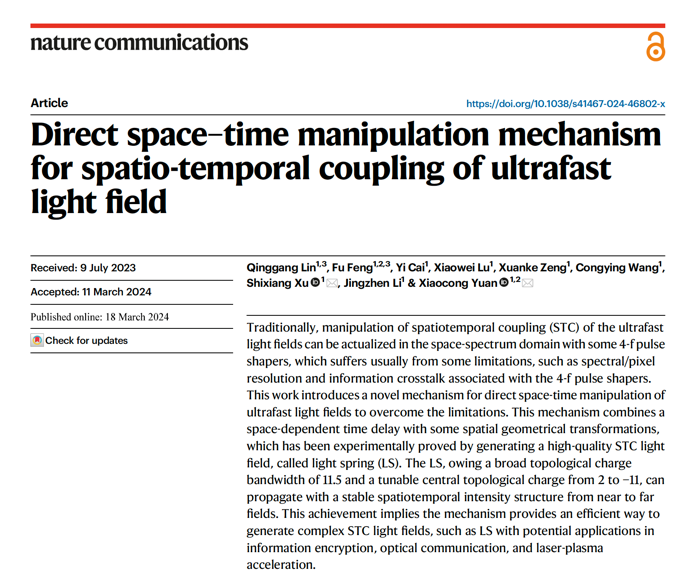Due to the ultrafast temporal characteristics of optical fields, direct spatiotemporal control of optical fields using optical modulation is nearly impossible. Therefore, traditional control methods utilize the broad spectral properties of ultrafast optical fields and the inherent physical correlations between the temporal and spectral domains. By employing frequency-domain control combined with time-frequency transformations, traditional methods achieve spatiotemporal composite control of ultrafast optical fields. A typical design is based on a grating pair +4f imaging system, where amplitude/phase modulation is applied on its spectral surface to obtain different spatiotemporal coupled optical fields. However, this approach suffers from a series of drawbacks including low spectral resolution, diffraction dispersion effects, and small control delays.
In response, the research team proposed a new mechanism for spatiotemporal coupled control of ultrafast optical fields: directly implementing spatiotemporal control of optical fields by introducing spatially correlated time delays combined with two-dimensional spatial geometric changes. To validate the effectiveness of this new mechanism, the team further designed technical schemes to implement it. Through this approach, they experimentally obtained spatiotemporal coupled optical fields with simultaneous amplitude and phase vortex distributions (referred to as "optical springs"). While this concept of optical springs was proposed theoretically a decade ago, experimental reports have been lacking until now. Optical springs exhibit broadband spectral topological charges in the frequency domain and constant topological charges in the temporal domain. These characteristics make them promising for applications in laser plasma dynamics, information encoding, laser-driven electron acceleration, vortex terahertz pulse generation, and other areas. In the future, based on this control mechanism, different spatiotemporal coupled ultrafast optical fields can be obtained by controlling spatially correlated time delays and two-dimensional spatial combinations. The related findings were published in Nature Communications, with Dr. Qinggang Lin from Shenzhen University and Dr. Fu Feng from Zhejiang Laboratory as co-first authors, and Professors Shixiang Xu and Xiaocong Yuan as corresponding authors. Shenzhen University is the first completion unit.

The paper link
https://www.nature.com/articles/s41467-024-46802-x.pdf


![]() Add : No. 3688, Nanhai Avenue, Nanshan District, Shenzhen, Guangdong Province
Add : No. 3688, Nanhai Avenue, Nanshan District, Shenzhen, Guangdong Province ![]() Email : cpoe@szu.edu.cn
Email : cpoe@szu.edu.cn ![]() Phone: 0755-26538735
Phone: 0755-26538735 ![]() Fax : 0755-26538735
Fax : 0755-26538735